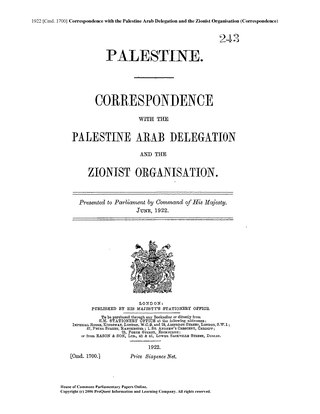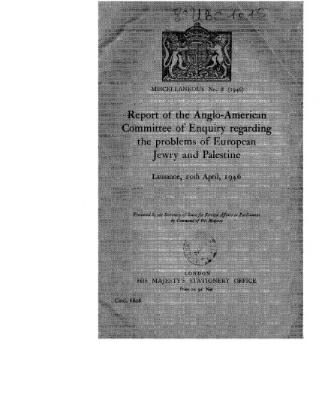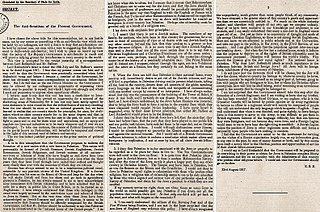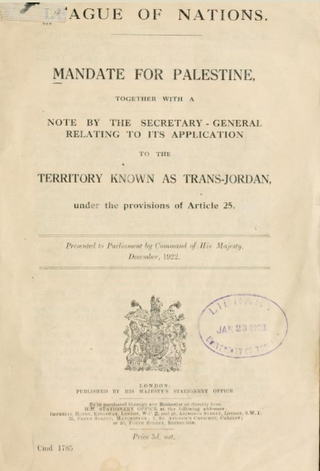Related Research Articles

The Balfour Declaration was a public statement issued by the British Government in 1917 during the First World War announcing its support for the establishment of a "national home for the Jewish people" in Palestine, then an Ottoman region with a small minority Jewish population. The declaration was contained in a letter dated 2 November 1917 from the United Kingdom's Foreign Secretary Arthur Balfour to Lord Rothschild, a leader of the British Jewish community, for transmission to the Zionist Federation of Great Britain and Ireland. The text of the declaration was published in the press on 9 November 1917.

Mohammed Amin al-Husseini was a Palestinian Arab nationalist and Muslim leader in Mandatory Palestine. Al-Husseini was the scion of the al-Husayni family of Jerusalemite Arab nobles, who trace their origins to the Islamic Prophet Muhammad.

The Churchill White Paper of 3 June 1922 was drafted at the request of Winston Churchill, then Secretary of State for the Colonies, partly in response to the 1921 Jaffa Riots. The official name of the document was Palestine: Correspondence with the Palestine Arab Delegation and the Zionist Organisation. The white paper was made up of nine documents and "Churchill's memorandum" was an enclosure to document number 5. While maintaining Britain's commitment to the Balfour Declaration and its promise of a Jewish national home in Mandatory Palestine, the paper emphasized that the establishment of a national home would not impose a Jewish nationality on the Arab inhabitants of Palestine. To reduce tensions between the Arabs and Jews in Palestine the paper called for a limitation of Jewish immigration to the economic capacity of the country to absorb new arrivals. This limitation was considered a great setback to many in the Zionist movement, though it acknowledged that the Jews should be able to increase their numbers through immigration rather than sufferance.

Yishuv, HaYishuv HaIvri, or HaYishuv HaYehudi Be'Eretz Yisra'el denotes the body of Jewish residents in Palestine prior to the establishment of the State of Israel in 1948. The term came into use in the 1880s, when there were about 25,000 Jews living in that region, and continued to be used until 1948, by which time there were some 630,000 Jews there. The term is still in use to denote the pre-1948 Jewish residents in Palestine, corresponding to the southern part of Ottoman Syria until 1918, OETA South in 1917–1920, and Mandatory Palestine in 1920–1948.

The 1920 Nebi Musa riots or 1920 Jerusalem riots took place in British-controlled part of Occupied Enemy Territory Administration between Sunday, 4 April, and Wednesday, 7 April 1920 in and around the Old City of Jerusalem. Five Jews were killed and several hundred injured; four Arabs were killed, and eighteen injured; 7 Britons were injured. The riots coincided with and are named after the Nebi Musa festival, which was held every year on Easter Sunday, and followed rising tensions in Arab-Jewish relations. The events came shortly after the Battle of Tel Hai and the increasing pressure on Arab nationalists in Syria in the course of the Franco-Syrian War.

The Jaffa riots were a series of violent riots in Mandatory Palestine on May 1–7, 1921, which began as a confrontation between two Jewish groups but developed into an attack by Arabs on Jews and then reprisal attacks by Jews on Arabs. The rioting began in Jaffa and spread to other parts of the country. The riot resulted in the deaths of 47 Jews and 48 Arabs, with 146 Jews and 73 Arabs wounded.

The King–Crane Commission, officially called the 1919 Inter-Allied Commission on Mandates in Turkey, was a commission of inquiry concerning the disposition of areas within the former Ottoman Empire.

The Anglo-American Committee of Inquiry was a joint British and American committee assembled in Washington, D.C., on 4 January 1946. The committee was tasked to examine political, economic and social conditions in Mandatory Palestine and the well-being of the peoples now living there; to consult representatives of Arabs and Jews, and to make other recommendations 'as may be necessary' to for ad interim handling of these problems as well as for their permanent solution. The report, entitled "Report of the Anglo-American Committee of Enquiry Regarding the Problems of European Jewry and Palestine", was published in Lausanne on 20 April 1946.

Zionist Commission for Palestine was a commission chaired by Chaim Weizmann, president of the British Zionist Federation following British promulgation of the pro-Zionist, Balfour Declaration. The Commission was formed in March 1918 and went to Palestine to study conditions and submit recommendations to the British authorities.
As an organized nationalist movement, Zionism is generally considered to have been founded by Theodor Herzl in 1897. However, the history of Zionism began earlier and is intertwined with Jewish history and Judaism. The organizations of Hovevei Zion, held as the forerunners of modern Zionist ideals, were responsible for the creation of 20 Jewish towns in Palestine between 1870 and 1897.

The Haycraft Commission of Inquiry was a Royal Commission set up to investigate the Jaffa riots of 1921, but its remit was widened and its report entitled "Palestine: Disturbances in May 1921". The report blamed the Arabs for the violence, but identified a series of grievances concerning the way their interests were apparently being subsumed to the interests of the Jewish immigrants, who were then around 10% of the population and increasing rapidly. Some measures to ease Arab unhappiness were taken, but Jewish communities were helped to arm themselves and ultimately the report was ignored. Publishing it was considered a propitiatory measure.
The Palestinian people are an ethnonational group with family origins in the region of Palestine. Since 1964, they have been referred to as Palestinians, but before that they were usually referred to as Palestinian Arabs. During the period of the British Mandate, the term Palestinian was also used to describe the Jewish community living in Palestine.

During the British rule in Mandatory Palestine, there was civil, political and armed struggle between Palestinian Arabs and the Jewish Yishuv, beginning from the violent spillover of the Franco-Syrian War in 1920 and until the onset of the 1948 Arab–Israeli War. The conflict shifted from sectarian clashes in the 1920s and early 1930s to an armed Arab Rebellion against British rule in 1936, armed Jewish Revolt primarily against the British in mid-1940s and finally open war in November 1947 between Arabs and Jews.

Anti-Zionism is opposition to Zionism. Although anti-Zionism is a heterogeneous phenomenon, all its proponents agree that the creation of the modern State of Israel, and the movement to create a sovereign Jewish state in the region of Palestine—a region partly coinciding with the biblical Land of Israel—was flawed or unjust in some way.

Events in the year 1920 in British-administered Palestine.
The Muslim National Associations (MNA) was a Zionist-inspired and funded organization founded in Mandatory Palestine in the 1920s. It had branch offices in a number of Palestinian towns, and was led by the mayor of Haifa, Hassan Bey Shukri and Sheikh Musa Hadeib, head of the farmers' party of Mount Hebron.
The 1933 Palestine riots were a series of violent riots in Mandatory Palestine, as part of the intercommunal conflict in Mandatory Palestine. The riots erupted on 13 October 1933 when the police broke up a banned demonstration organized by the Arab Executive Committee. The riots came as the culmination of Arab resentment at Jewish migration after it surged to new heights following the rise of Nazi Germany, and at the British Mandate authorities for allegedly facilitating Jewish land purchases. The second mass demonstration, at Jaffa in October, turned into a bloodbath when police fired on the thousands-strong crowd, killing 19 and injuring some 70. The "Jaffa massacre", as Palestinians called it, quickly triggered further unrest, including a week-long general strike and urban insurrections that resulted in police killing 7 more Arabs and wounding another 130 with gunfire.

The Mandate for Palestine was a League of Nations mandate for British administration of the territories of Palestine and Transjordan, both of which had been conceded by the Ottoman Empire following the end of World War I in 1918. The mandate was assigned to Britain by the San Remo conference in April 1920, after France's concession in the 1918 Clemenceau–Lloyd George Agreement of the previously agreed "international administration" of Palestine under the Sykes–Picot Agreement. Transjordan was added to the mandate after the Arab Kingdom in Damascus was toppled by the French in the Franco-Syrian War. Civil administration began in Palestine and Transjordan in July 1920 and April 1921, respectively, and the mandate was in force from 29 September 1923 to 15 May 1948 and to 25 May 1946 respectively.

Mandatory Palestine was a geopolitical entity that existed between 1920 and 1948 in the region of Palestine under the terms of the League of Nations Mandate for Palestine.
This is a timeline of intercommunal conflict in Mandatory Palestine.
References
- ↑ Huneidi, 2001, p.35
- ↑ FO 371 - Foreign Office: Political Departments: General Correspondence from 1906-1966; FO 371/5121 - Turkey. Code 44 File 85 (papers 8154 - 9913)
- ↑ Mr S. Alexander of the firm R. S. Devonshire & Co. Advocates, Cairo, cited Huneidi, p27.
- ↑ Palin Report 1920, British National Archives (FO 371/5121) p.41:"Dr. de Sola Pool gave as his definition of the word that it meant 'an attack on the Jews of the city carried out by the lower lawless elements who were given free play by the non-interference of the police and those charged with the keeping of order. Not necessarily with the connivance of the Government, but almost invariably of the lower police officials'."
- ↑ Henry Laurens, La Question de Palestine Fayard, Paris, vol.1 1999 p.525. It translates This animal is very nasty If he is attacked he defends himself